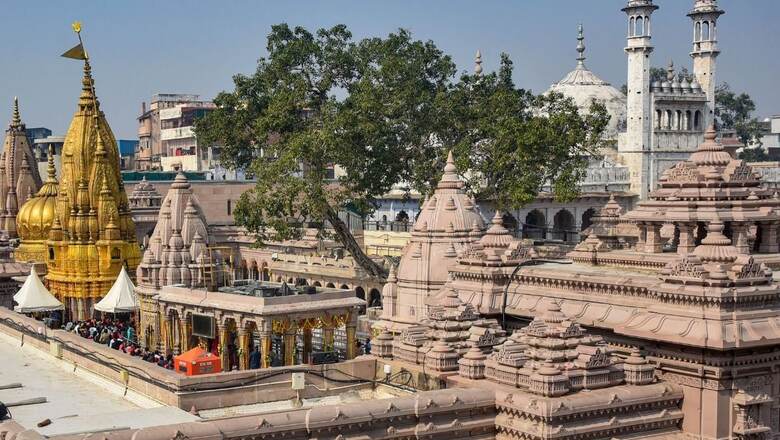
views
It all started with a long-standing demand for the construction of a Ram temple at the contested site where Mir Baqi, a commander of the Mughal emperor Babur in Ayodhya, built a disputed edifice in 1528-1529 (935 AH). Some individuals, particularly those who supported the Lutyens’ cabal, rejected the moving 1990s saying “Ayodhya to bas jhanki hai, Kashi-Mathura baaki hai” (Ayodhya was merely a glimpse; Kashi-Mathura would follow suit) as empty rhetoric. However, the emotion behind the shout appears to have set in motion a cascade of events that should not be stopped.
Shringar Gauri Worship Suit 2022
In Rakhi Singh & others, Varanasi district judge A K Visvesha ruled that the five Hindu women’s petition is maintainable under the Civil Procedure Code (CPC) 1908, noting that the petitioners are not seeking to convert the Gyanvapi mosque into a Shiva temple or claiming ownership. They are just seeking the freedom to worship as a civil right; hence, the 1991 Act’s prohibition is inapplicable. The Places of Worship Act, its validity, and what it allows or prohibits is at the centre of the spiralling controversy. The Places of Worship Act exempts judicial proceedings, lawsuits, and appeals that began after August 15, 1947.
As a result, it obstructed judicial investigations into the factual and historical nature of religious sites. In response to Ram Mandir’s efforts at revival, the Congress administration hastily passed this contentious and obscure act in 1991. Many people believe this was a constitutional shield to prevent investigations into thousands of gruesome Islamic-occupied Hindu temples, including Mathura and Varanasi.
The Background
Since the Islamic invasion of India in the 11th century, the destruction of Hindu temples has been nothing but an unceasing practice, as the Prophet is reported as desecrating idols and razing a pagan temple to seek the assent of Kaba, all based on the provisions established in the Holy Quran, citing a few:
- The total devastation and extermination of Kafirs and polytheists (40:70).
- Hindus (the pagans) are described as the worst of creatures (98:6).
- Non-believers in Islam face eternal burning (4:56).
- Allah is the only deity that must be worshipped (40:62).
- So combat the devil’s minions (4:76).
- “Fight against them until idolatry is no more” (2:193).
- “Idolatry is worse than carnage” (2:217).
As Muslim marauders desecrated temples, slaughtered Brahmins, committed mass rapes and enslaved women, their intolerance was reflected in their savagery. The Somnath temple was destroyed 17 times, displaying Islamists’ religious intolerance for anything non-Islamic. The Taliban’s destruction of the Buddha of Bamyan is a recent example of Islamist supremacist ideology that values exclusionary authoritarianism over humanity’s most valuable treasures. Throughout history, Islamist conquerors have converted Hindu temples into mosques in order to debase, demoralise and denigrate Hindus who refused to convert.
The Places of Worship (PoW) Act was passed without consultation with Hindus, and the Law Commission did not conduct an investigation at the government’s request. No one debated the bill’s impact on Indian communities’ Article 25 rights. The PoW Act unconstitutionally limits communities’ ability to seek legal redress for historical and civilisational abuses. The Act palpably appears to be gravely unjust and invalid and ought to be overturned.
ASI’s involvement in the Kashi Vishwanath Temple survey
The ASI, tasked with determining whether the mosque—which began the survey of the site on August 4, 2023—was “constructed over a pre-existing structure of a Hindu temple” then submitted its report to the court in a sealed cover, which is now open for the world to see following the Varanasi district court’s orders on January 24, 2024. According to the ASI investigation, a big Hindu temple existed prior to the construction of Varanasi’s Gyanvapi Masjid. “Based on scientific studies and surveys carried out, studies of architectural remains, exposed features and artefacts, inscriptions, art and sculptures, it can be said that there existed a Hindu temple prior to the construction of the existing structure.” Among a multitude of finds, the ASI also exhumed numerous Telugu, Tamil, and Kannada inscriptions within the Gyanvapi Mosque. Prior to the temple’s destruction and forced conversion into a mosque, pilgrims from the south and academics who visited it inscribed these. This is but one instance of how the Kashi Vishvanath Temple unified Bharat.
The Catch
The 1958 Ancient Monuments and Archaeological Sites and Remains Act protects archaeological sites and ancient monuments, so it is not applicable to them under the 1991 Places of Worship Act. The appellants requested an ASI-led archaeological survey. Since the ASI team discovered the Shivling and other Hindu relics in the complex, the structure should be exempt from the Places of Worship Act since it is subject to court procedures under the Ancient Monuments and Archaeological Sites and Remains Act.
In his exhaustive work ‘Hindu Temples: What Happened To Them’, historian Sitaram Goel wrote, “The mosque of Benares, built by Aurangzeb, was constructed on the site of the Bisheshwar (Vishwanath) Temple.” The temple was exceedingly tall and considered very holy among Hindus. He built a towering mosque on this precise place, using those very stones, and rearranged the ancient stones once they were embedded in the mosque’s walls. They are happy to call a mass movement “majoritarianism” or “Hindu communalism” but if there is no mass movement, people question the veracity of the claims. Estimates put the number of temples destroyed by “invaders” at over 1800.
It is unsurprising that modern Muslims who visited the supposed Islamic construction known as the “Gyanvapi Mosque” were aware of the Shivling and chose to refer to it as their wazookhana, or the bathroom where they cleansed their bodies. The fact that Muslim clerics present during the survey attempted to prevent the recording by using a poor reason, “the fish might die,” attests to this. What sort of fraternity do these Muslims have for Hindus, and should Hindus reconsider secularism? After all, temples were constantly demolished across Bharat.
Sitaram Goel and Arun Shourie, historians, have written extensively on the subject, including efforts to “secularise” history. In his article titled ‘Hideaway Communalism’, Shourie uncovered the efforts of numerous significant academies to bury original manuscripts that detailed and glorified the destruction of temples in various sections of the country by invaders, as well as the rationale for such devastation. In any case, because it is a matter of property and religious rights, no one may make concessions on behalf of affected temples and communities.
Negationism cannot pass as secularism in New India. It is time for us, as Indians, to ask these questions.
- In retrospect, is it fair to assume that the Islamic pillagers, who hailed from rags in the desert and never built any mosque or building of any kind anywhere in the world, who coveted water and left riches behind, came to India and suddenly began building monuments like the Taj Mahal, Red Fort, and Qutub Minar?
- Let alone the construction; the name of the putative Islamic structure, Gyanvapi, is a Sanskrit word. Why would a zealot who only wants to follow the Quran use a Sanskrit term for a mosque when everything else is repulsive, vile, and undesirable to him?
- Should the Indian state be regarded as smart and sagacious if it continues to oppress the Hindu population by enforcing the Abrahamic religious annexure on the key foundations of Hindu society, namely temples? Islamic sectarianism has concentrated on the most revered Hindu places, including Shri Ram Janmabhoomi, Shri Krishna Janmabhoomi, and thousands of other temples.
- Isn’t the chain of terrorist attacks on Hindu pilgrims, such as the burning of train compartments containing Karsewaks in Godhra, as well as the recent bombing of a bus to Vaishno Devi, motivated by the same religious motives as the Islamists who destroyed temples in the first place?
- Is there any cessation to the ever-perpetual jihad of the Islamic conquest of Bharat—which most Hindus in India are unaware of—a major factor in the formation of Pakistan and modern-day Bangladesh, till the ideas of Ghazwa-e-Hind and Dar al-Islam live?
- Doesn’t this suggest that those who oppose the Hindu regaining of seized territories are ignorant of historical facts?
Yuvraj Pokharna is an independent journalist and columnist. He tweets with @iyuvrajpokharna. Here’s the link to Yuvraj’s official WhatsApp channel: https://whatsapp.com/channel/0029VaBKt038vd1QvwLPp515. Views expressed in the above piece are personal and solely that of the author. They do not necessarily reflect News18’s views.















Comments
0 comment